
Alaska Fisheries Sonar
Kenai River King Salmon Sonar Transitions
Transition to River Mile 14 Site
In an effort to better assess early and late run king salmon abundance on the Kenai River, the Alaska Department of Fish and Game transitioned from the sonar site at River Mile (RM) 9 to a new site upstream at RM 14 beginning in 2013.
In 2013 and 2014, the department operated sonars at both RM 14 and RM 9 as part of a research project to determine if the king salmon runs could be assessed by sonar at RM 14. Findings from the research project showed that the RM 14 sonar provided king salmon abundance assessments that were equivalent, on average, to the expanded estimates used for in-season management of the fishery from the sonar located at RM 9. The new location allowed sonar technology to span nearly the entire width of the river, which increased the accuracy of assessments. Beginning in 2015 the RM 9 sonar was discontinued, and king salmon abundance estimates are now assessed using sonar at the RM 14 site.
Large Fish Escapement Goal FAQ
Transition to Large Fish Escapement Goals for Inseason Management
Estimates of king salmon passage by Adaptive Resolution Imaging Sonar (ARIS) at RM 14 are made by using two sources of information. The first source is an estimate of king salmon greater than about 34 inches in total length passing the sonar. Nearly all large fish counted by sonar are king salmon, so this count is very accurate and is considered a direct estimate of fish greater than 34 inches in total length passing the sonar. This estimate is expanded to the hour from the amount of time the sonar is operating during each hour of each day.
The second source of information is estimated from the department’s inriver netting project at RM 9 and is designed to estimate the passage of small king salmon, those less than about 34 inches in length. Although abundance of large king salmon can be directly assessed by sonar alone, assessing the abundance of all king salmon (regardless of size) requires sonar data supplemented by additional information from the inriver netting project. The netting data provide the size information necessary to estimate the number of king salmon that are too small (less than 34 inches) to be distinguished from sockeye, coho, and pink salmon. Such estimates are produced by fitting statistical mixture models to sonar and netting data. During netting, captured fish are measured and the ratio of small to large king salmon passing the sonar is estimated. Since the count of large king salmon is estimated directly by sonar and ratio of small to large king salmon is estimated from netting, this ratio is applied to fish passage estimates to determine the proportion of all species of small fish counted by the sonar that are small king salmon. Together these sources provide data to estimate the total passage of all sizes of king salmon. Unfortunately, this method is sensitive to inseason variations and has required significant post season adjustments.
Prior to the 2017 season, ADF&G developed escapement goals based upon large king salmon to replace existing goals based on king salmon of all sizes. Direct estimates of large king salmon (approximately 34 inches total length and larger) as measured by the sonar are more accurate, timely and can be produced without netting data. In addition, bias in passage estimates associated with small fish are not an inseason management issue using large fish escapement goals because daily mixture model estimates to incorporate small king salmon are not required. Mixture model estimates of all king salmon (regardless of size) continue to be produced post season for ongoing assessment of stock productivity.
Sonar operations at RM 14 begin on May 16 and continue through approximately August 20. The management objective for the early- and late-run king salmon fisheries is the achievement of the large fish escapement goals (3,900-6,600 early run; 15,000-30,000 late run).
- Sonar page
- Kenai King Sonar Fish Counts
- Spawner-Recruit Analyses and Escapement Goal Recommendations for Kenai River Chinook Salmon
- Sonar Transition Memo (PDF 377 kB)
- Northern Kenai Peninsula Management Area
Site Transition Frequently Asked Questions
What guides the management of the Kenai River early and late king salmon runs?
ADF&G manages the Kenai River king salmon runs in accordance with the Kenai River and Kasilof River Early-run King Salmon Conservation Management Plan and the Kenai River Late-Run King Salmon Management Plan. Both were established through the Board of Fisheries process.
How does ADF&G measure king salmon escapement on the Kenai River?
Escapement is measured in two steps. First, king salmon passing RM 14 are counted with sonar. The sonar (Soundmetrics ARIS TM) uses projected sound to detect passing fish and displays those fish visually on a computer screen. The computer also records these images for processing with software that allows the passing fish to be measured for length. All fish approximately 34 inches and above that pass upstream through the sonar beam are counted as large king salmon. The second step to determine escapement is to subtract all large king salmon fishing mortality that occurs above RM 14. King salmon fishing mortality is tallied by ADF&G creel surveys. ARIS is currently the most advanced and best available sonar for counting fish migrating in large glacial rivers like the Kenai River.
How do the king salmon counts at the Kenai River Mile 14 sonar site compare to the historic counts at the River Mile 9 sonar site?
Typically, the two sights showed similar year end numbers although some differences were detected. Figure 1 below is our assessment of king salmon passage of all sizes using the RM 9 and the RM 14 sonars during 2013 and 2014 when both sites were operated simultaneously. Counts from the RM 9 site required expansion factors (see graph legend) that are not required at RM 14.
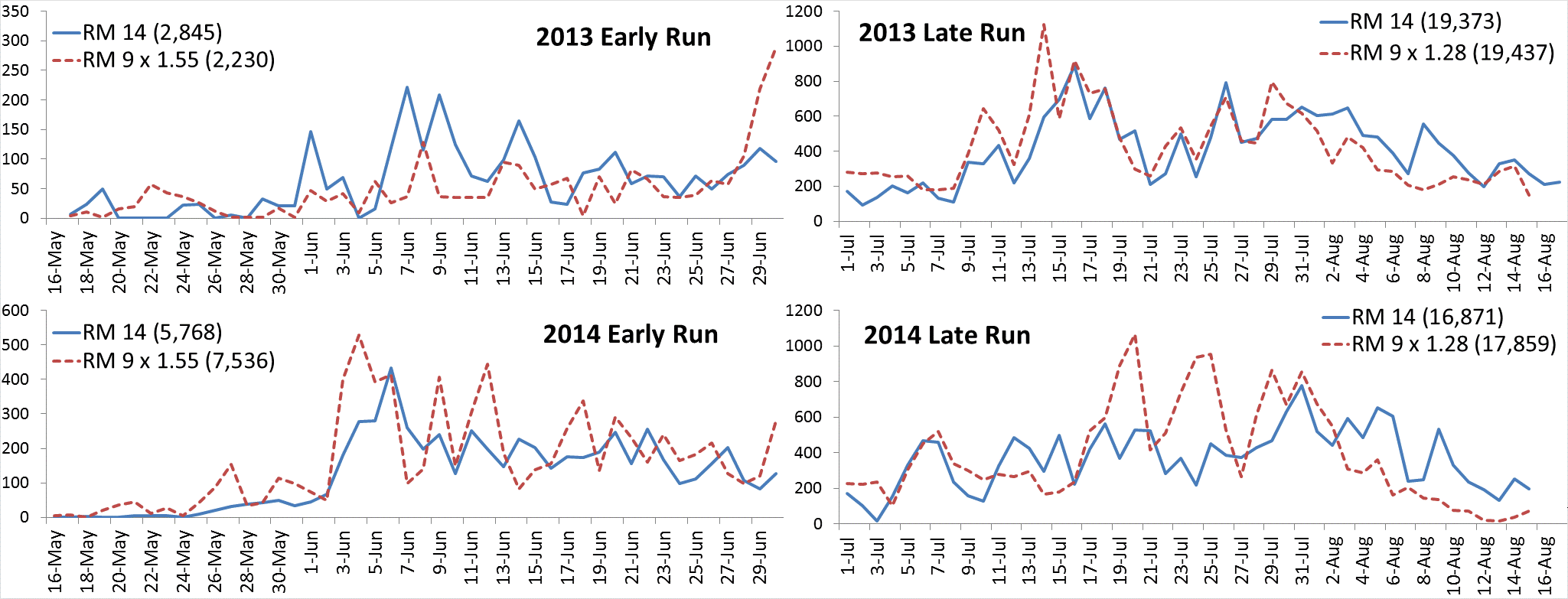
Figure 1.- Daily abundance estimates of Kenai River king salmon of all sizes as measured by sonar sites at RM 9 and RM 14, 2013 and 2014.
Does ADF&G use the same expansion factors at the River Mile 14 sonar site?
No. The expansion factors are not used because the five sonar arrays at RM 14 span nearly the entire river width and are not needed.
Does the Kenai River king salmon assessment at River Mile 14 include the test netting program?
Yes, although the abundance of large king salmon can be directly assessed by the sonar alone, the assessment of the abundance of all king salmon (regardless of size) requires sonar data be supplemented by additional information from the test netting project. The netting data provide the size information necessary to estimate the number of king salmon that are too small to be distinguished from sockeye, coho, and pink salmon (those fish less than 34 inches). Inseason assessments are based on large fish only (greater or equal to 34 inches as measured by sonar). Abundance of all sizes of king salmon is estimated post season using a combination of RM 14 sonar data and RM 9 netting data.
Does the abundance of small king salmon affect the escapement estimates or inseason management decisions on the Kenai River king salmon runs?
No. Inseason management decisions are based on inseason estimates of large king salmon escapement (greater than or equal to 34 inches) and are, therefore, not affected by the presence of small king salmon (See Large Fish Escapement Goal FAQ below for explanation of large fish length and management).
Does the sonar detect fish that are less than 20 inches in size?
Yes, the sonar detects all sizes of fish, but only large king salmon (greater than or equal to 34 inches) are tallied for management. The recorded sonar files do contain all fish that pass the beam if this number is needed at a later date.
Does the historical mid-point or halfway point of early and late king salmon run at River Mile 14 occur on the same date as River Mile 9 or is it later because the sonar is 5 miles further upstream?
No; The mid-point is not the same as the historical mid-point estimated from data collected at RM 9. The median date of early-run passage (regardless of fish size) was 4 days earlier at RM 14 than at RM 9 in 2013, but no different in 2014 (Figure 2). Median date of late-run passage (regardless of fish size) was 4 days later at RM 14 than at RM 9 in 2013, and 6 days later in 2014 (Figure 3). Radio-telemetry results were consistent with these findings: Chinook salmon radio-tagged at RM 9 began to exhibit less consistent upstream migration in late July.
Findings show that information for inseason management based on the RM 14 sonar will be delayed as fish transit the five additional miles upstream before abundance is estimated. This is especially true during the late run, when migration seems to slow or pause between the sites. The run timing midpoint for large king salmon based on mean run timing at RM 14 for the years 2013-2017 is June 11 for the early run and July 27 for the late run (Figures 4 and 5).
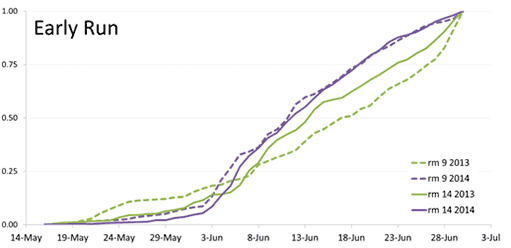
Figure 2. Early run Kenai River king salmon cumulative run timing of all sizes of fish as measured by sonar sites at RM 9 and RM 14, 2013 and 2014.
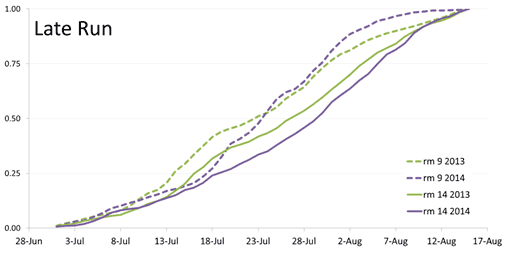
Figure 3. Late run Kenai River king salmon cumulative run timing of all sizes of fish as measured by sonar sites at RM 9 and RM 14, 2013 and 2014.
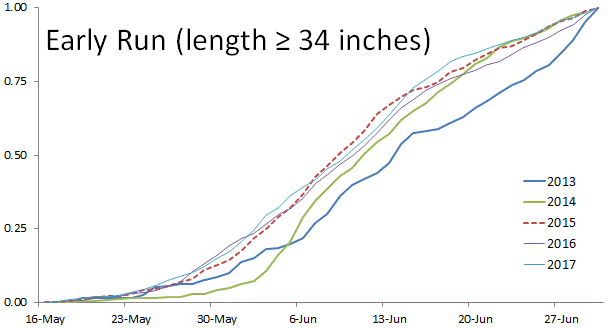
Figure 4. Early run Kenai River large king salmon (greater than or equal to 34 inches) cumulative run timing as measured by sonar at RM 14, 2013-2017.
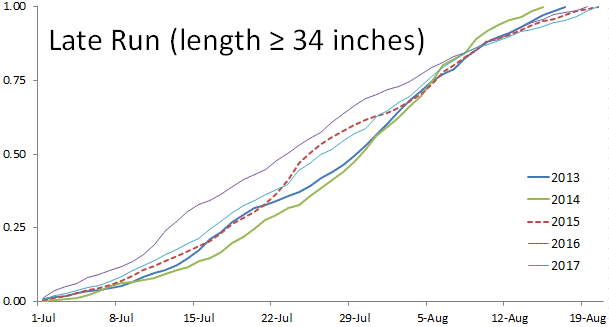
Figure 5. Late run Kenai River large king salmon (greater than or equal to 34 inches) cumulative run timing as measured by sonar at RM 14, 2013-2017.
How does ADF&G keep track of the sport harvest occurring downstream of River Mile 14?
The sport harvest is estimated inseason by ADF&G creel survey personnel and provides harvest estimates both above and below RM 14.
Do king salmon spawn downstream of River Mile 14?
Yes. Telemetry projects conducted from 2012-2014 estimate that on average 4.0% of radio-tagged late run king salmon completed migration and spawned downstream of RM 14. Spawning occurs after the sport fishery closes on July 31 from mid-August through September.
Large Fish Escapement Goal Frequently Asked Questions
Why were the escapement goals changed from goals based on fish of all sizes to goals based only on large fish?
The number of large fish (those 34 inches or larger in total length) can be assessed quickly and more accurately. Large fish abundance can be assessed using only the sonar, and fish of this size represents most of the female king salmon that are important to productivity of the stock. Estimates of the inriver run of fish of this size passing the sonar can be generated daily making management more responsive to changes in abundance.
What is a “large fish goal”?
A large fish goal is an escapement goal based only on fish greater than a chosen size. For the Kenai River, king salmon 34 inches or greater in total length has been chosen to establish the escapement goal. In Southeast Alaska, nearly all king salmon stocks have goals based on fish greater than a minimum size of 26 inches mid-eye to tail fork.
Why are the large fish goals lower than the old goals?
The large fish goals have a lower numeric value because they only include large fish, but they provide similar probabilities of producing maximum sustained yield (MSY) for both runs, and maximum recruitment for the early-run, as well as avoiding overfishing.
Why are the large fish goals sustainable escapement goals and not biological escapement goals?
There is still considerable uncertainty in the abundance of large fish in previous years. This uncertainty includes the run reconstruction, especially with the estimation of escapement, and the lack of return data from escapements at the lower bound of the goal. Due to this uncertainty, a biological escapement goal cannot be calculated at this time.
Why was 34 inches total length chosen as minimum size considered for the goal?
34 inches total length is the smallest king salmon that the imaging sonar can reliably distinguish from all sizes of sockeye salmon. Ninety percent of all female Kenai River king salmon are 34 inches or greater in total length and more than half of all king salmon of this size are female. King salmon smaller than 34 inches total length include all of the 1-ocean fish (age 1.1) and nearly all of the 2-ocean fish (age 1.2), which are primarily males.
How do the large fish goals improve management of the fisheries?
Our inability to assess small fish reliably inseason is no longer a contributing factor in the timeliness and accuracy of decision making on inseason management actions. Therefore, whatever management actions we take are more likely to be the appropriate action.
Do you continue to estimate the abundance of small king salmon?
Yes. The netting and harvest sampling programs will continue to collect data to estimate abundance of all sizes of king salmon but the estimation of abundance of small fish has become a post-season task. These small fish do spawn so estimation of the abundance of all sizes is needed for preseason run size estimates in following years.
Has the sonar project changed how it conducts sampling since transitioning to large fish escapement goals?
No. The sonar program has remained the same. The ARIS sonar system, located at the RM 14 site, is composed of multiple individual transducers scheduled to operate 10 minutes per hour for each location, 24 hours per day. There will be 1–3 spatial strata (distances from shore) sampled per transducer and 2–5 transducers deployed in the river at any given time. Detailed information on the sonar program can be found in the project operational plan: http://www.adfg.alaska.gov/FedAidPDFs/ROP.SF.2A.2017.11.pdf
How do you measure fish?
Estimates of the length of the fish passing the sonar beam are made from computer images generated from the ARIS sonar. The sonar image is frozen on the computer screen and the fish are measured by ADF&G technicians using a digital measurement tool. The accuracy of lengths obtained this way using the ARIS sonar image were independently verified by using a fish of a known length tethered in front of the sonar beam. Additionally, harvested fish sampled in commercial and sport fisheries are measured mid-eye to fork of tail in centimeters directly with a measuring tape.
How do you estimate the harvest of large fish in the commercial fishery?
Total commercial harvest is derived from fish tickets submitted to the department. The department samples the commercial set gillnet harvest inseason for age, sex, length (MEF), and genetic material. This information is used to stratify the harvest by size and different biological groupings (Kenai River mainstem, Kenai River tributary, Kasilof River, and Cook Inlet other).
How do you estimate the harvest of large fish in the sport fishery?
Sport harvest downstream of the Soldotna Bridge is sampled as part of the creel survey and can be stratified by size. Presently, regulations prohibit the harvest of king salmon less than 34 inches above the Soldotna Bridge. Estimates of catch and release mortality of large king salmon above the Soldotna Bridge are made indirectly using the Statewide Harvest Survey and information from the inriver gillnetting program about the size structure of the king salmon run.
How do you estimate the harvest of large fish in the personal use fishery?
The personal use fishery harvest of kings is estimated post-season based on returned personal use permits that report catching a king in the Kenai River dipnet fishery, as well as information provided by the inriver gillnetting program about the size structure of the king salmon run.
How is the Kenai River king salmon fishery managed if size or age composition of the run changes over time?
Similar to all other department escapement goals, over time, these large fish goals will allow for sustainable fisheries with normal variation in size compositions. Size or age compositions of the annual king salmon runs depend on the survival or strength of individual brood years, with multiple brood years comprising each annual run. The size or age composition of the run is different each year. In recent years, when abundance of Kenai River runs were well below average, the composition of small fish was higher. However, in 2015 -2018 the abundance of fish and composition of large fish increased in both runs.
Does run timing of large fish differ from fish of all sizes?
Yes by 1-4 days on average. Because the department has a more accurate assessment of large fish – they can be measured directly from sonar sampling, while small fish are estimated based on the sonar and netting data combined – we have better estimates of run timing of large fish than for all fish. Based on ARIS data from 2013 – 2019, the early-run median date of passage was June 10 for large king salmon and June 11 for all king salmon. In all years, the early-run large king salmon midpoint occurred within 2 days of the midpoint for all early-run king salmon.
For the late run, the median date of passage observed in the 2013–2019 ARIS data was 4 days later for large king salmon in comparison to all king salmon. The run timing midpoint based on mean run timing is July 27 for late-run large king salmon and July 23 for all late-run king salmon. On average for the late-run, approximately 32% of the large fish late-run has passed the RM 14 sonar by July 20, and approximately 63% of the large fish late-run has passed by August 1.
How does later run timing of large fish affect management decisions?
Management actions will likely continue to occur during the same time period they have historically been implemented. The department uses multiple sources of information to aid in determining run timing inseason, such as commercial set gillnet harvest, inriver test netting, inriver sport harvest, and sonar passage.
